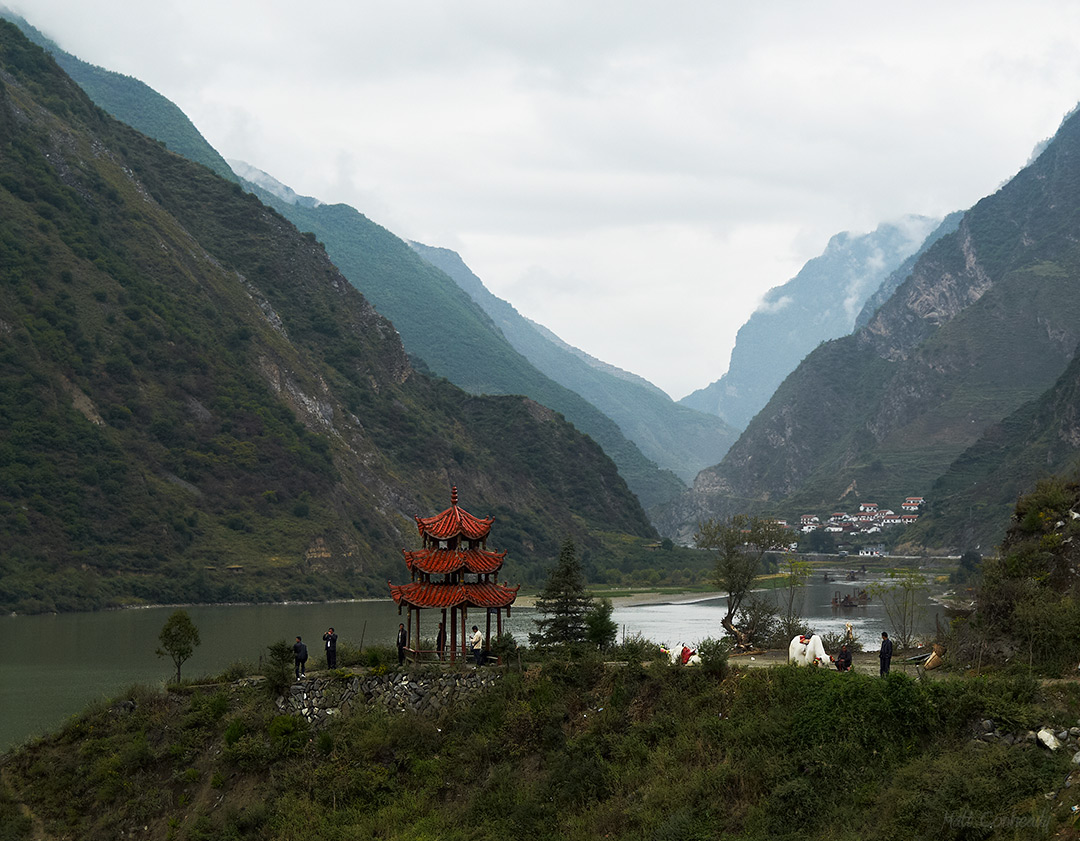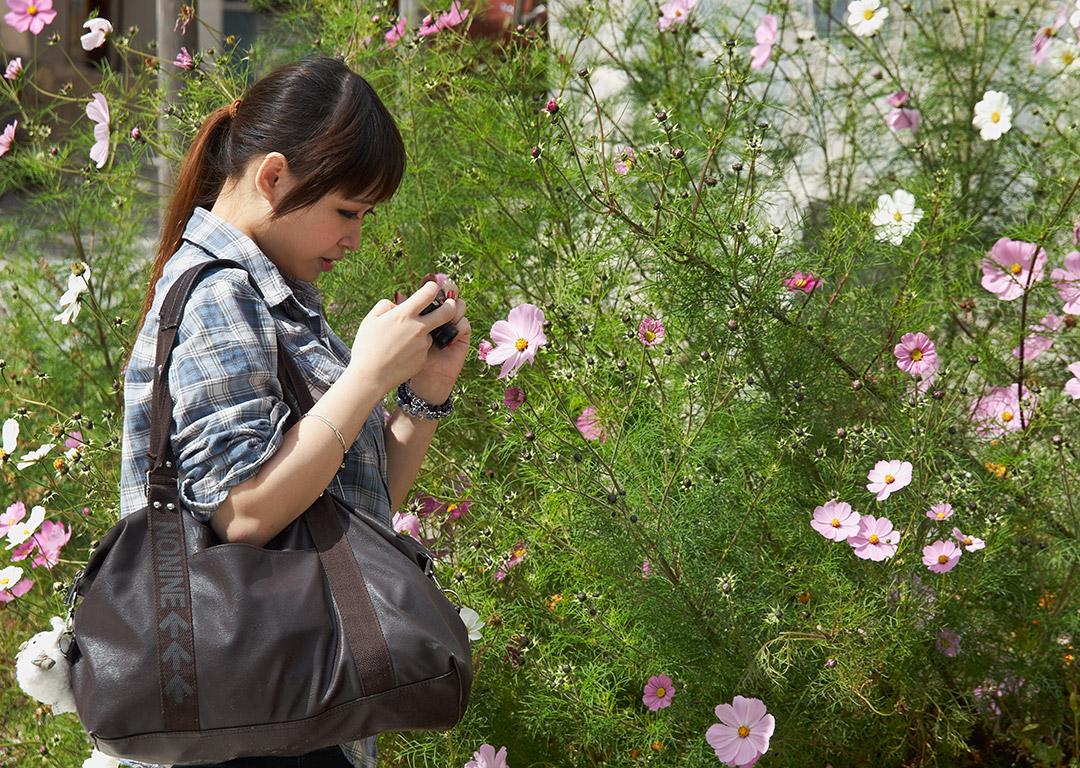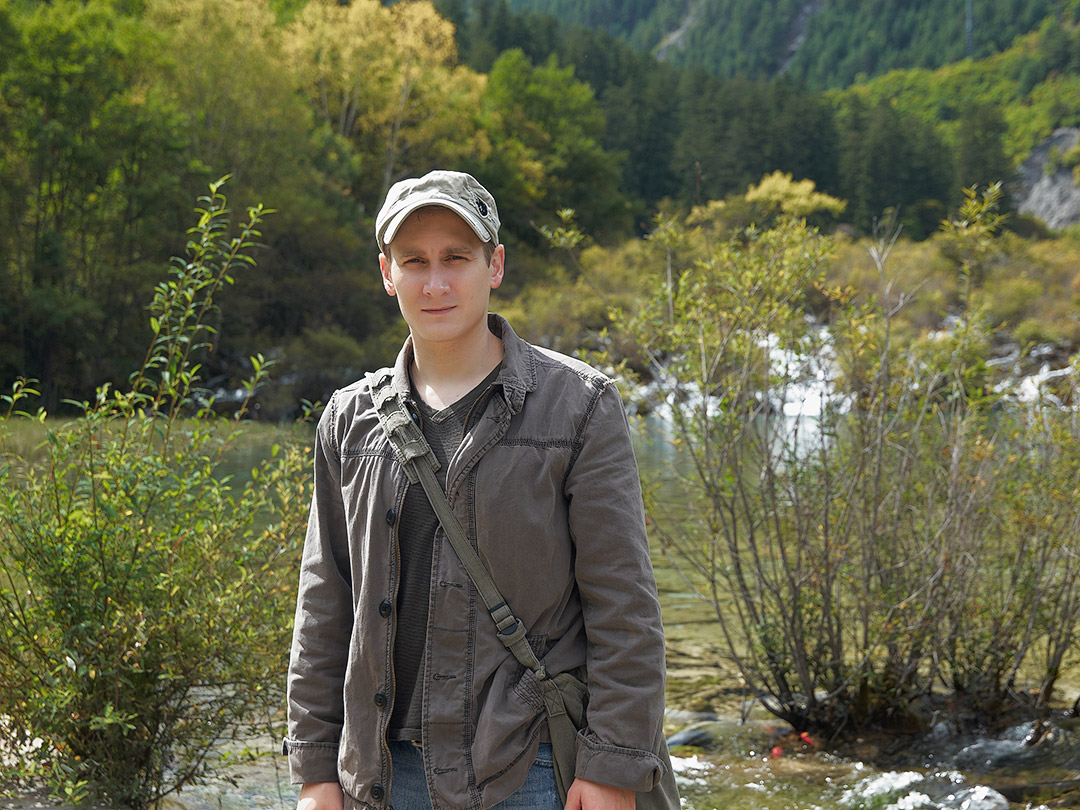Off to Jiuzhaigou Valley

Joni and I are companions on the “10” hour bus ride to Jiuzhaigou Valley in the Tibetan Plateau, just 424km north of Chengdu. The bus is far from comfortable. No AC, no heat. Windows don’t really open. No restroom. Barely any brakes. The driver is intent on never stopping… but since the bus would break down every once an a while he seldom had a choice where we stop.
Immediately as we leave Chengdu we are in the mountains (Chengdu is surrounded by mountains, but you rarely see them because of all the smog) the region opens up into massive river valley. The mountains here are limestone. Fragile and aged, they crumble easily and landslides are common. This is the region that suffered the heaviest casualties from the 2008 earthquake. Whole villages were covered by boulders. I didn’t realize it at the time, but the road we took up the valley was freshly built, and in some areas construction was still in-progress. On the other side of the river was the ruins of the former highway and all the villages, farms and even traffic that fell victim to that devastating quake.
Along the way, we passed hundreds of small villages, each one with their own tourist “attraction.” Some are massive ornate bridges, others are colossal statues of ancient Chinese warriors. Some of the best were reproductions of castles, forts and temples from the warlord era. Of more interest to me was the style of the homes in each village. Although they didn’t differ drastically, each village had some defining style characteristic to their design. Usually something ornate about the roof. Almost all of the smaller villages utilized personal solar generators for electricity and hot water.

We would hit a rest stop ever hour or two, though there were plenty along the way. Families, even villages, would have economies centered around the highway. One rest stop would have a cafeteria, snacks and drinks, pay restrooms (one yuan/one time), a hose for washing the bus, cooling down the brakes and engine, and often people in native clothing and/or with Tibetan Yaks for tourist photos. Competition for buses and cars to stop is intense. Often whole families would stand in the road with signs trying to wave traffic into their stop.


Fruit and nut vendors at one rest stop.

This village built this pagoda as part of their tourism program to encourage visitors to stop. This and a couple of rest stops is all this village has.

At a large rest stop on the way we were told this was the place to stop for a full meal. We has maybe 20 minutes to eat. A kitchen was cranking out random dishes as people scooped them up. It was chaos and we realized we wouldn’t get the meal we wanted. We grabbed this pork one (I’m not a fan of wood ear). It was ok… especially considering it was a roadside rest-stop. It wasn’t enough so we figured we’d eat our fill when we arrived.

The bus ride ended updating 14 hours at least. Even with the bus driver only lightening on the pedal when we reach unexpected snow showers at high altitudes. This is when Joni realized she only packed summer clothes. We were hungry, cold and I had to pee. The streets were so packed with cars and buses, our driver couldn’t make it to the stop, so we decided to bail and walk the 2 miles to our rooms in freezing rain. Fortunately, in China, everyone with a car and some bills to pay can be a taxi. It cost me a whopping 100 yuan for a ride just shy of 2 miles. Ridiculous, but I think Joni would have froze to death otherwise.
We reached the hotel in the dark and once in, we took advantage of the in-hotel restaurant, and had a few Sichuan dishes brought up to the room.
We ordered a lot of dishes that I was familiar with… and we ate a ton.
I have eaten a lot of spicy foods thus far, but nothing compared to this plate of pain. Fried chilies. The aroma these things breathed into the air was enough to burn my sinuses. Eating them was pretty standard for a super hot dish… red face, sweat, runny nose, a bit of coughing…. followed by breathing through the nose to avoid inhaling more fumes. Each swallow was followed by a rush of endorphins and adrenalin as the body accomplished the amazing feat of eating something it would normally consider a toxin. Eating hot, I can handle on rare occasions. And to the senses this seemed like just another night of pizza and hot wings. That is until it hit my empty stomach. The capsaicin just scorched my insides and gave me a rush of energy and a feeling i have never felt before. This is the hottest thing I have eaten and probably will ever eat. It was delicious and I never considered PAIN to be a quality associated with flavor before this.
But it was good, like running past your body’s wall.. it hurts but it feels good, and then afterwards your body is beaten and sore, but you are glad you did it.

A cold dish of slices of bamboo, which has a wonderful texture and crunch to it, and the mild white sauce made this a great balance to offset some of the heat from the peppers.

Wonderfully prepared Sichuan pork (much better than the previous time we had it). So much pork, and the perfect amount of veggies.

It was a big mistake. I was up all night puking.
About 5 in the morning I was vomiting fire.
By morning I had little strength and my stomach felt like it could turn at any moment. We made it to Jiuzhaigou Valley around noon. I took my time. I was so hungry, but I couldn’t eat. It was a beautiful day for photographing mountains, but not for waterfalls or water… and I really didn’t feel like photographing anyways. We are now in the Min Shan mountain range on the edge of the Tibetan Himalayan Plateau. We are high.. the air is thin… the sun is hot… the shade is ice cold. Everything is tiring. Even peeing is tiring… hiking is exhausting. But I’m here and I won’t get this chance again. We took a car out to the park.
For 4 days I was vomiting… oddly enough only at night around 4-5 am. No sleep until that relief, then maybe an hour or two after. The mornings would feel horrible with a slight fever and a wariness to eat anything. Luckily the fruit juices there have quite a bit of substance in the form of large quantities of pulp, or gelatin or tapioca pearls imitating pulp. These got me through the morning, giving me the energy to hike in the mountains, and later in the day I would feel better enough to take on some solids… then … 5 am rolls around again and I’m puking it all up.
Lesson learned. Out of all the times I ate street food, in fifthly restaurants, questionable foods. I never got sick. Room service at a nice hotel: food poisoning.
Jiuzhaigou Valley UNESCO World Heritage Site
Jiuzhaigou Valley is massive, but it does have one main road that can get you to all the good spots. Go off the road and you can see some Tibetan villages, cool waterfalls and lakes, and possibly get mauled by a panda.
This is the main entrance to Jiuzhaigou. It is a Tibetan-style building. Inside are office, guides, a bunch of food vendors and a souvenir shop with a lot of crap.

After yesterday’s rain and snow, today turned beautiful Not ideal conditions for photographing water features, but it felt good to have some sun and warmth for a change.

This is what Jiuzhaigou is all about. This lush valley contains three distinct gullies that are packed with blue-to-green colored lakes and thousands of waterfalls. The high concentration of calcium carbonate from the limestone bedrock is what gives the water its varied colors, and in many locations creates waterfalls. The high concentrations of minerals in the water, precipitate out onto rocks, trees, and other calcium deposits, creating natural dams for water to spill over. This layering, combined with the high fertility of the valley has resulted in a river filled with golden plants, emerald pools and refreshing whitewater. It’s an amazingly colorful sight. Its even more amazing, considering Jiuzhaigou only recently became protected (1980s) that China hasn’t destroyed this place already.

Photos taken in bad direct sun… not great but really shows how the river lights up gold in the sun.


The name Jiuzhaigou means “9 village Valley,” for the 9 Tibetan villages along its length. Since the road was built and the valley being declared a protected area (and agriculture prohibited), two of the villages furthest from the road were abandoned. Villagers now rely solely on crafts and tourism for income.
This is one of the Tibetan villages. Think it is Shuzheng Village. It’s relatively close to the entrance to the valley so it’s popular with tourists.



You can find corn pretty much everywhere in China (it’s a grain native to the Americas)


Tibetan prayer flags are strung up anywhere they can be. Each flag is inscribed with a prayer.




On the other side of this road, and on the shore of the river is this old grist mill. This mill is older than the United States. Kudos to the Chinese for preserving it and making it accessible. It’s a pretty neat place for tourists because here the boardwalk is close to the river, and leads to a sizable waterfall.


We crossed the river to get a better view of the village. It took about an hour to get to the other side.

Calcium-tolerant algae love these shallows, but for the most part not many living things can grow within the deep pools. Fallen trees will remain preserved for decades.

Portrait time – Joni avoided illness and looks pretty healthy.

I’m walking dead.

I recall forgetting to buy drinks before heading out to this side of the river, and then being terribly thirsty. With all that rushing water around, I just wanted to get out and get a cold water.

Not a particular stunning scene, but I love how the cool blue water cuts through a relatively warm scene.


The doorway of an old sawmill.

One of the deeper lakes… I don’t recall the name.

No tripod on this trip, and even if i decided to bring one, it would have killed me to lug it around. Thus, I’m shooting in direct sun, handheld… not ideal for waterfalls, but at least I’m getting decent exposures considering how much glare these scenes had.


A handheld shot of the whitewater at the base of Shuzheng Waterfall, which I believe to be primarily a natural stone waterfall, rather than one comprised mostly of calcium deposits. You can tell this from the boulders that make up its structure.


The crest

The lake above the waterfall

The water gets deeper in depth and color

You can see the bottom way out into the lake. Reminded me of Green Lakes State Park near Syracuse, but the water here is clearer.

From running a website about waterfalls, I know about all types of mills, or at least I thought I did… Here is a new one for all of us… a religious mill.
For Tibetan Buddhists, the continuous recital of prayer in words or mind is important to keeping the pursuit of enlightenment.
Prayer wheels, beads, and charms usually contain written prayers. The rotation of these prayers (always in a clockwise motion) is considered to be the equivalent of verbal recital of the prayer. One device for “spinning prayer” is the prayer wheel. Which are often positioned in rows, which people will walk around in a clockwise direction, spinning the wheels (also clockwise).
Here I found a mill type with the sole purpose of keeping a giant prayer wheel spinning. Numerous mills like this lined the banks of the river above the waterfall, and the creaky sound of the brass prayer wheels on their wooden frames, and the chime of dozens of bells complemented the serenity of the the slow-moving water. This was my favorite part of the park.

Here’s some Chinglish for you. This was in the bus station/tourist center.

Sick and in the mountains, I opt for this corn-fried rice, which is what really old people and babies eat. All starches and no flavor. Puked it all up later.

There was a bus to get back… these people were ahead of us in line.

I don’t recall there being much of a nightlife around the park. Most likely due to myself being ill the whole time. I may have just missed it.

Write a Reply or Comment